Shrub
This article needs additional citations for verification. (October 2018) |
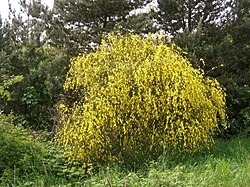
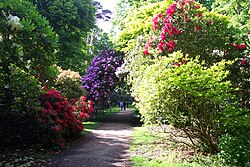
A shrub or bush is a small-to-medium-sized perennial woody plant. Unlike herbaceous plants, shrubs have persistent woody stems above the ground. Shrubs can be either deciduous or evergreen. They are distinguished from trees by their multiple stems and shorter height, less than 6–10 m (20–33 ft) tall.[1][2] Small shrubs, less than 2 m (6.6 ft) tall are sometimes termed as subshrubs. Many botanical groups have species that are shrubs, and others that are trees and herbaceous plants instead.
Some define a shrub as less than 6 m (20 ft) and a tree as over 6 m. Others use 10 m (33 ft) as the cutoff point for classification.
Compared to trees and herbaceous plants, a small number of shrubs have culinary usage. [ they are normally harvested from shrub-sized plants, but these would be large enough to become small trees if left to grow instead.
Definition
Shrubs are perennial woody plants, and therefore have persistent woody stems above ground (compare with succulent stems of herbaceous plants).[2] Usually, shrubs are distinguished from trees by their height and multiple stems. Some shrubs are deciduous (e.g. hawthorn) and others evergreen (e.g. holly).[2] Ancient Greek philosopher Theophrastus divided the plant world into trees, shrubs and herbs.[5]
Small, low shrubs, generally less than 2 m (6.6 ft) tall, such as
Most definitions characterize shrubs as possessing multiple stems with no main trunk below.
Use in gardens and parks
An area of
Shrubs in common garden practice are generally considered
Botanical structure
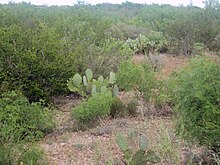
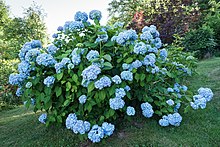
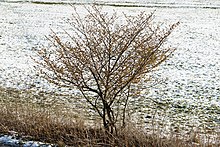

In botany and ecology, a shrub is more specifically used to describe the particular physical canopy structure or plant life-form of woody plants which are less than 8 metres (26 ft) high and usually multiple stems arising at or near the surface of the ground. For example, a descriptive system widely adopted in Australia is based on structural characteristics based on life-form, plus the height and amount of foliage cover of the tallest layer or dominant species.[13]
For shrubs that are 2–8 metres (6.6–26.2 ft) high, the following structural forms are categorized:
- dense foliage cover (70–100%) — closed-shrubs
- mid-dense foliage cover (30–70%) — open-shrubs
- sparse foliage cover (10–30%) — tall shrubland
- very sparse foliage cover (<10%) — tall open shrubland
For shrubs less than 2 metres (6.6 ft) high, the following structural forms are categorized:
- dense foliage cover (70–100%) — closed-heathor closed low shrubland—(North America)
- mid-dense foliage cover (30–70%) — open-heath or mid-dense low shrubland—(North America)
- sparse foliage cover (10–30%) — low shrubland
- very sparse foliage cover (<10%) — low open shrubland
List
Those marked with * can also develop into tree form if in ideal conditions.
- A
- Abelia (Abelia)
- Acer(Maple) *
- Actinidia (Actinidia)
- Aloe (Aloe)
- Aralia (Angelica Tree, Hercules' Club) *
- Arctostaphylos (Bearberry, Manzanita) *
- Aronia (Chokeberry)
- Artemisia (Sagebrush)
- Aucuba (Aucuba)
- B
- Berberis (Barberry)
- Bougainvillea (Bougainvillea)
- Brugmansia (Angel's trumpet)
- Buddleja (Butterfly bush)
- Buxus (Box) *
- C
- Calia(Mescalbean)
- Callicarpa (Beautyberry) *
- Callistemon (Bottlebrush) *
- Calluna (Heather)
- Calycanthus (Sweetshrub)
- Camellia (Camellia, Tea) *
- Caragana (Pea-tree) *
- Carpenteria (Carpenteria)
- Caryopteris (Blue Spiraea)
- Cassiope (Moss-heather)
- Ceanothus (Ceanothus) *
- Celastrus (Staff vine) *
- Ceratostigma (Hardy Plumbago)
- Cercocarpus (Mountain-mahogany) *
- Chaenomeles (Japanese Quince)
- Chamaebatiaria (Fernbush)
- Chamaedaphne (Leatherleaf)
- Chimonanthus (Wintersweet)
- Chionanthus (Fringe-tree) *
- Choisya (Mexican-orange Blossom) *
- Cistus (Rockrose)
- Clerodendrum (Clerodendrum)
- Clethra (Summersweet, Pepperbush) *
- Clianthus (Glory Pea)
- Colletia (Colletia)
- Colutea (Bladder Senna)
- Comptonia (Sweetfern)
- Cornus(Dogwood) *
- Corylopsis (Winter-hazel) *
- Cotinus (Smoketree) *
- Cotoneaster (Cotoneaster) *
- Cliffrose)
- Crataegus (Hawthorn) *
- Crinodendron (Crinodendron) *
- Broom) *
- D
- Daboecia (Heath)
- Danae(Alexandrian laurel)
- Daphne (Daphne)
- Decaisnea (Decaisnea)
- Dasiphora (Shrubby Cinquefoil)
- Dendromecon (Tree poppy)
- Desfontainea(Desfontainea)
- Deutzia (Deutzia)
- Diervilla (Bush honeysuckle)
- Dipelta(Dipelta)
- Dirca (Leatherwood)
- Dracaena (Dragon tree) *
- Winter's Bark) *
- Dryas (Mountain Avens)
- E
- Edgeworthia (Paper Bush) *
- Elaeagnus (Elaeagnus) *
- Chilean Firebush) *
- Crowberry)
- Enkianthus (Pagoda Bush)
- Ephedra(Ephedra)
- Trailing Arbutus)
- Erica (Heath)
- Eriobotrya (Loquat) *
- Escallonia (Escallonia)
- Eucryphia (Eucryphia) *
- Euonymus (Spindle) *
- Exochorda (Pearl Bush)
- F
- Fabiana (Fabiana)
- Fallugia (Apache Plume)
- Fatsia (Fatsia)
- Forsythia (Forsythia)
- Fothergilla (Fothergilla)
- Franklinia (Franklinia) *
- Fremontodendron (Flannelbush)
- Fuchsia (Fuchsia) *
- G
- Garrya (Silk-tassel) *
- Salal)
- Gaylussacia (Huckleberry)
- Broom) *
- Loblolly-bay) *
- Grevillea (Grevillea)
- Griselinia (Griselinia) *
- H
- Hakea (Hakea) *
- Silverbell) *
- Halimium (Rockrose)
- Hamamelis(Witch-hazel) *
- Hebe(Hebe)
- Hedera (Ivy)
- Helianthemum (Rockrose)
- Hibiscus (Hibiscus) *
- Hippophae (Sea-buckthorn) *
- Hoheria (Lacebark) *
- Creambush)
- Hudsonia (Hudsonia)
- Hydrangea (Hydrangea)
- Hypericum (Rose of Sharon)
- Hyssopus (Hyssop)
- I
- Ilex (Holly) *
- Star Anise) *
- Indigofera (Indigo)
- Sweetspire)
- J
- Jamesia (Cliffbush)
- Jasminum(Jasmine)
- Juniperus(Juniper) *
- K
- Kalmia (Mountain-laurel)
- Kerria(Kerria)
- Beauty-bush)
- L
- Lagerstroemia (Crape-myrtle) *
- Lapageria (Copihue)
- Lantana (Lantana)
- Lavandula (Lavender)
- Lavatera(Tree Mallow)
- Ledum(Ledum)
- Leitneria (Corkwood) *
- Lespedeza (Bush Clover) *
- Leptospermum (Manuka) *
- Leucothoe (Doghobble)
- Leycesteria (Leycesteria)
- Ligustrum(Privet) *
- Lindera (Spicebush) *
- Linnaea (Twinflower)
- Lonicera(Honeysuckle)
- Lupinus (Tree Lupin)
- Lycium (Boxthorn)
- M
- Magnolia (Magnolia)
- Mahonia (Mahonia)
- Acerola)
- Menispermum (Moonseed)
- Menziesia (Menziesia)
- Medlar) *
- Microcachrys (Microcachrys)
- Myrica (Bayberry) *
- Myricaria (Myricaria)
- Myrtus and allied genera (Myrtle) *
- N
- O
- P
- Pachysandra (Pachysandra)
- Paeonia (Tree-peony)
- Persoonia (Geebungs)
- Philadelphus (Mock orange) *
- Jerusalem Sage)
- Photinia (Photinia) *
- Physocarpus (Ninebark) *
- Pieris (Pieris)
- Pistacia (Pistachio, Mastic) *
- Pittosporum (Pittosporum) *
- Plumbago (Leadwort)
- Polygala (Milkwort)
- Poncirus*
- Prunus (Cherry) *
- Antelope Bush)
- Pyracantha (Firethorn)
- Q
- R
- Rhamnus(Buckthorn) *
- Rhododendron (Rhododendron, Azalea) *
- Rhus(Sumac) *
- Ribes (Currant, Gooseberry)
- Romneya (Tree poppy)
- Rosa (Rose)
- Rosmarinus (Rosemary)
- Salmonberry, Wineberry)
- Rue)
- S
- Sabia *
- Salix (Willow) *
- Salvia (Sage)
- Sambucus (Elder) *
- Santolina (Lavender Cotton)
- Sapindus (Soapberry) *
- Senecio (Senecio)
- Simmondsia (Jojoba)
- Skimmia (Skimmia)
- Smilax (Smilax)
- Sophora (Kōwhai) *
- Sorbaria (Sorbaria)
- Spartium (Spanish Broom)
- Spiraea (Spiraea) *
- Staphylea (Bladdernut) *
- Stephanandra(Stephanandra)
- Styrax *
- Symphoricarpos (Snowberry)
- Lilac) *
- T
- Tamarix (Tamarix) *
- Taxus (Yew) *
- Telopea (Waratah) *
- Thuja cvs. (Arborvitae) *
- Thymelaea
- Thymus (Thyme)
- Trochodendron *
- U
- Ulex (Gorse)
- Ulmus pumila celer (Turkestan elm – Wonder Hedge)
- Ungnadia (Mexican Buckeye)
- V
- Vaccinium (Bilberry, Blueberry, Cranberry)
- Verbesina centroboyacana
- Verbena(Vervain)
- Viburnum (Viburnum) *
- Vinca (Periwinkle)
- Viscum (Mistletoe)
- W
- Weigela (Weigela)
- X
- Xanthoceras
- Xanthorhiza (Yellowroot)
- Xylosma
- Y
- Yucca (Yucca, Joshua tree) *
- Z
- Zanthoxylum *
- Zauschneria
- Zenobia
- Ziziphus *
References
- ISBN 978-1-84407-079-4.
- ^ OCLC 1097073225.
- ^ "Life Spans of Small Trees and Shrubs". McCabe's Landscape Construction. 2014-02-27. Retrieved 2022-04-29.
- ^ Clayton, Liz (20 October 2021). "Is The Coffee Plant A Tree, Bush, Or Shrub?". sprudge.com. Retrieved 2022-04-29.
- ISBN 9780140238020.
- ISBN 978-1-56799-319-6.
... Examples of subshrubs include candytuft, lavender, and rosemary. These broad definitions are ...
- ^ "What is a Subshrub?". World of Flowering Plants. 2017-05-15. Retrieved 2022-04-29.
- ISBN 978-1-85623-008-7.
- ISBN 9780643101975. Retrieved 19 December 2017 – via Google Books.
- ^ "Rejuvenation or Renewal Pruning to Restore Overgrown Shrubs". Organic Plant Care LLC | Organic Lawn & Plant Health Service in Hunterdon, Morris, Somerset & Union Counties, NJ and Bucks County, PA. 2019-02-21. Retrieved 2022-04-29.
- ^ Turpin, Jason (2018-08-29). "What is Selective Tree and Shrub Pruning-How to Prune Correctly!". Turpin Landscape Design/Build. Retrieved 2022-04-29.
- ISBN 9781429012904. Retrieved 19 December 2017 – via Google Books.
- ^ Chris Paul (2024). The Best Evergreen Shrubs for Front Yards. Shrubs Radar, a website all about shrubs.
